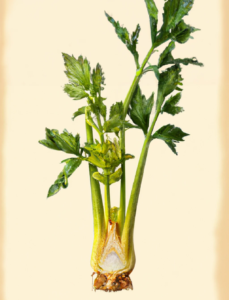Celery is more than just an addition to a vegetable snack tray! It’s very good for you and can help balance a number of issues. Munching on celery is beneficial too, but let’s take a look beyond.

Image of Celery by Kathy McCabe with AI assistance.
Herb: Celery & Celery Seed
Latin Name Apium graveolens
Family Apiaceae
Ayurvedic / TCM Name: Qin Cai
Parts Used: Stalks, dried seed, leaves
Native Region: Medeterranian
Geographic Distribution: Generally, there are four different varieties. Distribution is cultivated: In Asian marshlands, the leaf celery (Chinese celery; Apium graveolens var. secalinum variety is cultivated. Leaf celery has thinner stalks and a stronger taste. In Europe, the celeriac (celery root, Apium graveolens var. rapeceum) variety is grown.
The hypocotyl bulb (formed by the seedling and becomes the most used part of this variety) is a main ingredient, leaves are used for flavoring, while the smaller fibrous stalks are seldom used. In the wild, the variety is known as smallage. Its leaves are wedged, and the stalk grooved. North American growers predominantly grow the Pascal variety which has hardier stems. They are available in white or red.
Botanical Description: Typically, celery is a bi-annual plant, meaning it doesn’t flower until the second year. (Speaking of the North American Variety) Stalks are fibrous and ribbed, grow in bunches (smallest to the center of the bunch), and can be upwards of a foot in length at the outside. Leaves are pinnate to bipinnate, and feathery in nature. Seeds are generally very small, brown, and round.
Harvesting Guidelines: (Again, speaking of the North American Variety) Fields are harvested when a desired average stalk length is gained. Most of the leaves are removed. Every second year the celery flowers and after the flowers fall off the celery seeds will form. They are harvested when they are hard and dark, and when they begin to fall off at a touch (Grant, GardeningKnowHow.com)
Constituents: Volatile oils, glycosides, furanocoumarins, flavonoids, Vitamins K, A & C, folate, potassium
Uses: Celery’s culinary use is widely known. Personally, I use celery seed infusions to help knock down gout. (I’ve had gout in my big toe since age 16 – no one knows why since I didn’t eat poorly, or too richly, and didn’t drink alcohol.) Thank heavens for it since it works extremely well.
Celery is also useful for lowering inflammation, reducing blood pressure, arthritis/gout reduction, digestive stimulant, externally as a massage oil to reduce arthritic inflamed joints, and as a foot bath for gout-inflamed feet. Effective in treating cystitis, helping to disinfect the bladder and urinary tubules (Easley & Horne, 2016)
Actions: carminative, antispasmodic, diuretic, emmenagogue, nervine, stimulant, sedative (medicinal amounts), urinary antiseptic, antirheumatic
Preparations Dosage & Safety Infusions, tinctures, juices, oils.
Celery Seed Infusion (Kathy’s personal remedy): 1.5 tsp organic celery seed infused covered in 8 ounces of freshly boiled water for 15 minutes. Strain and drink in one sitting. Repeat up to 3 times daily during active gout attack to flush the excess uric acid (literally).
Taste: Bitter, earthy, slightly sweet, pungent
Energy: According to Culpepper, celery is an herb of Mercury, it is hotter, drier, and is more medicinal than parsley (Culpepper, 1653 (2019 edition edited by Steven Foster)). Slightly Cool and moist (Penelope Ody, 2017).
Tincture: (Seeds 1:5, 50% alcohol, 10% glycerin) 10 drops to 2 ml (0.4 tsp) up to 3 times daily (Easley & Horne, 2016) Oil: 20 drops in a teaspoon of olive or almond oils. (Ody, 2017) Foot Bath: 15 drops of oil in warm water to soak the feet (Ody, 2017)
Capsules: 500-1500 mg up to 3 times a day (Easley & Horne, 2016)
UNSAFE during pregnancy as celery seeds and celery oil taken in medicinal amounts may cause contractions.
Allergy: celery can cause allergic reactions in people sensitive to wild carrots, mugwort, birch, and dandelion. In medicinal amounts, celery may increase the risk of bleeding and those with a bleeding disorder should not take medicinal amounts. (emedicinehealth.com) Traces of bergapten in the seeds may increase photosensitivity after using the extracted oil externally.
Internal use of the essential oil is not recommended for home use. (Penelope Ody, 2017)
Notes / References:
Gardening Know How, Saving Celery Seeds-How to Harvest Celery Seeds, Bonnie L. Grant (https://www.gardeningknowhow.com/edible/vegetables/celery/saving-celery-seeds.htm) Emedicine Health. (https://www.emedicinehealth.com/celery/vitamins-supplements.htm) Culpepper’s Complete Herbal, 2019 Illustrated & Annotated Edition edited by Steven Foster based on Culpepper’s 1653 Complete Herbal Volume 2) The Complete Medicinal Herbal; Penelope Ody, 2017 The Modern Herbal Dispensatory; A Medicine Making Guide. Thomas Easley, Steven Horne, 2016
As with any new medical or herbal regimen. please speak to your doctor first.

Kathy is an herbalist/naturopathic practitioner who is constantly researching to expand her knowledge. She came to herbalism after her migraine medicine was suddenly removed from the market and she had to find something new. After discovering the magic of herbs she’s never looked back. She is accredited by the International Practitioners of Holistic Medicine (IPHM) and is an Associate Member of the American Herbalist Guild.